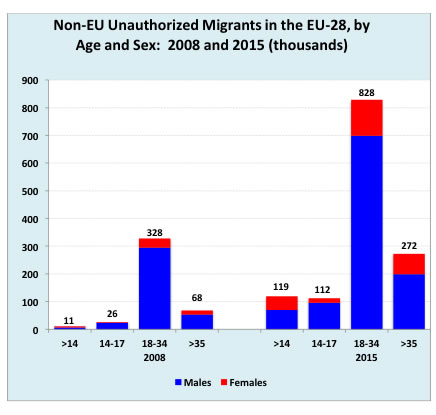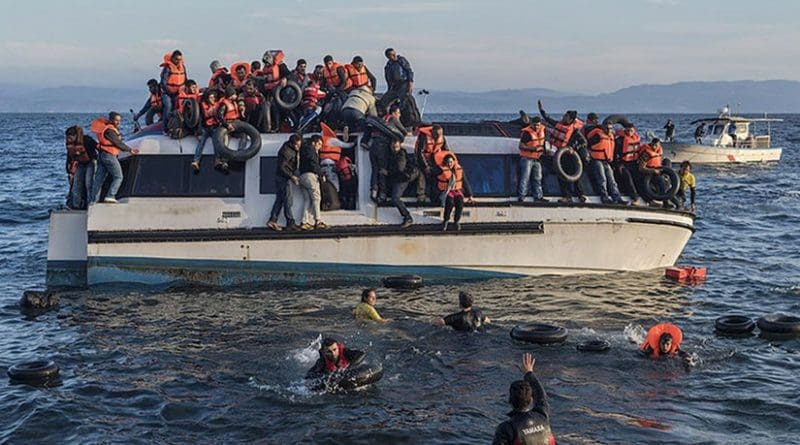Human Smuggling: Ruthless Crime Or Invaluable Service? – Analysis
The most desperate migrants seek help from smugglers and attract global sympathy – a dilemma for governments.
By Joseph Chamie*
Smuggling is a ruthless crime for governments, but for millions of people it’s regarded as an invaluable service. More than a decade ago, governments collectively adopted an international protocol to prevent and combat smuggling of migrants by land, sea and air. Nevertheless, people continue to rely on human smuggling as a means to improve their own personal lives as well as those of families and friends.
Certainly, human smugglers can be ruthless and unscrupulous, and smuggled migrants are vulnerable to abuse and exploitation. Still, asylum seekers and unauthorized migrants desire the service and are willing to pay. For many unauthorized migrants, smugglers are freedom facilitators.
Human smuggling is not a new phenomenon. In the distant past, many including religious luminaries, minorities, slaves, iconoclastic thinkers and political dissidents relied on smugglers to escape abuse, persecution and bondage. In more recent times such smuggling has expanded to include men, women and children fleeing poverty, unemployment, tyranny, violence, conflict, natural disasters and environmental degradation as well as simply seeking reunions with families.
Human smuggling is proving to be an attractive and profitable business often operated by organized criminal networks. The smuggling of migrants on two main routes – Africa to Europe and South America to North America – generates no less than an estimated $7 billion a year in revenue.
Under international law human smuggling is a crime defined as “the procurement, in order to obtain, directly or indirectly, a financial or other material benefit, of the illegal entry of a person into a State of which the person is not a national or a permanent resident.” The term “illegal entry” is defined as “crossing borders without complying with the necessary requirements for legal entry into the receiving State.”
Human smuggling and human trafficking are crimes with some similarities and three major differences: First, human smuggling involves the migrant’s consent of the migrant. A trafficking victim has either never consented or, if initially consenting, that is rendered meaningless by coercion, deception or abuse. Second, smuggling generally ends with the migrants’ arrival at their destination whereas trafficking involves continued exploitation. And third, while smuggling profits are derived from the transportation and facilitation of the illegal entry into another county, trafficking profits are derived from exploitation of the trafficked person.
Comprehensive data on the number of smuggled migrants are not readily available. While globally approximately 50 million people are estimated to be unauthorized migrants, many were not smuggled, but simply overstayed short-term visas. In the United States, for example, those overstaying exceeded the number who entered without authorization across the southern land border for each year from 2008 to 2012.
In contrast, more than 90 percent of the unauthorized migrants arriving in the European Union, peaking in excess of 1 million in 2015, were facilitated mostly by criminal smuggling networks. Most originated primarily from Syria, 40 percent; Afghanistan, 19 percent; Iraq, 8 percent; and Pakistan, 4 percent. Close to 90 percent of the unauthorized migrants are males, predominately aged 18 to 34 years.
 |
| Desperate escape: More than 90 percent of the unauthorized migrants arriving to the European Union are helped by smugglers, and most come areas of conflict (Source: Eurostat)
|
The supply of potential migrants wishing to go abroad exceeds the demand for migrants in immigrant-receiving countries. Moreover, most would-be migrants do not qualify for the limited legal immigration because they lack desired skills, education and training.
Some argue that issuing more immigration visas would go a long way in combating human smuggling. However, even doubling the number of visas currently issued would not come close to satisfying the demand, especially among developing countries with growing populations.
Enhanced border security is another proposal. However, enhanced border enforcement has a limited impact and instead contributes to enhanced smuggling efforts, more perilous journeys and higher fees. Some even claim that the walls, fences and barriers help the smuggling business by forcing migrants to rely on smugglers.
A related border measure employed by the EU is to blow up ships used to transport unauthorized migrants. Smugglers, in response, have relied on unseaworthy dinghies and inflatable rafts and even alert European patrol boats about migrants in need of rescue. The EU’s Frontex border agency reports a record 27,500 migrants rescued and brought to Italy in October 2016, the highest monthly total on record in the central Mediterranean.
Some analysts contend the establishment of open borders, permitting people to move freely across international borders, could end smuggling, but others reject this as bad policy, especially for countries with comparatively small populations, such as Bahamas, Bhutan, Israel, Kuwait, Singapore and Switzerland, whose demographic compositions would be drastically altered by open borders.
The smugglers are difficult to identify and prosecute. They are not generally known to the migrants or readily traceable. They utilize rental vehicles and change phones regularly. In addition, the smuggled migrants fear authorities and resist reporting abuses and exploitation.
Smuggling is a costly service and entails a range of facilitation services including transportation, accommodations, fraudulent documents and strategic information. While smuggling across a single border may cost several thousand dollars, smuggler fees involving long distances, multiple borders, fake documents and payoffs can cost tens of thousands of dollars.
Governments confront numerous challenges in preventing human smuggling.
Public perceptions of human smuggling are more benign when compared with the smuggling of drugs, firearms, organs and other illicit goods. Perceptions also vary in sending, transiting and receiving countries. Many consider human smuggling as permissible or even justified when helping those escaping persecution or desperate conditions. Some government officials, border guards and local police agencies look the other way, focusing efforts on organized crime networks, or they even assist the migrants, notes a November report on the Mediterranean Migration Crisis from MEDMIG.
Penalties are typically aimed at the smugglers and not the migrants. Provisions of the international protocol on human smuggling stresses that smuggled migrants shall not become liable to criminal prosecution and have the full protection of their basic human rights.
Smuggling groups in sending or transit countries often exploit ethnicity and nationality, selecting destinations where migrants will find communities with similar linguistic and cultural backgrounds. Established diaspora communities are generally sympathetic to the plight of such migrants.
In addition, smuggled migrants increasingly find safe havens and connections in receiving countries, such as sanctuary cities, which provide information, assistance and various benefits with reduced fear of repatriation to their home countries. Local organizations, charities, ethnic associations, churches, colleges and even some businesses facilitate integration. Moreover, in some nations, including the United States, enforcement efforts for the removal of unauthorized migrants prioritize convicted criminals and those posing threats to public safety, border security and national security.
Growing imbalances in economic opportunity combined with a large supply of would-be migrants in sending countries and limited demand for migrants in receiving countries provide considerable impetus, support and revenue for human smuggling.
Addressing the root causes of human smuggling is neither quick nor easy, and requires sustained developmental progress coupled with political stability, good governance and human security. In short, given current conditions in migrant sending, transit and receiving countries, human smuggling is a problem here to stay for the foreseeable future.
*Joseph Chamie is an independent consulting demographer and a former director of the United Nations Population Division.

